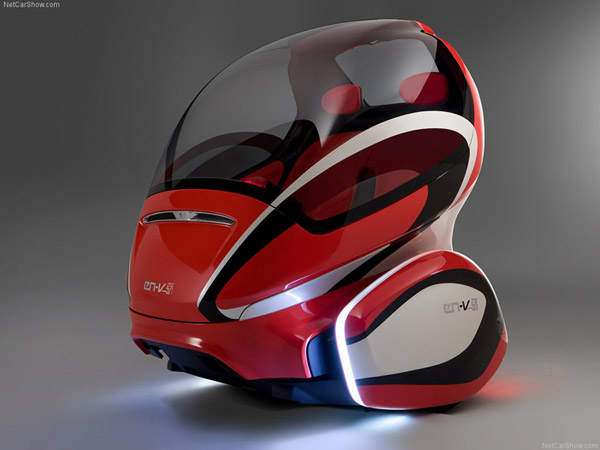Designing under population projections that by 2030 more than 60% of the world’s 8 billion people will live in urban areas, General Motors and its strategic partner SAIC (Shanghai Automotive Industry Corp), yesterday unveiled their EN-V concepts in Shanghai. The EN-V (Electric Networked-Vehicle) is a fully electric two-seater vehicle designed to alleviate urban blights like traffic congestion, parking availability, air quality and affordability in one sleek package. Three EN-V models were unveiled: Jiao (Pride) penned by designers at GM Europe, Xiao (Laugh) designed by GM Holden’s design team in Australia, and Miao (Magic) which was designed at the General Motors Advanced Design Studio in California. The concepts will be showcased from May 1-October 31 at the World Expo 2010 Shanghai — fitting, as Shanghai is expected to become one of the epicenters for personal mobility solutions in the future.
The EN-V evolved from last year’s P.U.M.A. (Personal Urban Mobility and Accessibility) prototype that was developed in conjunction with Segway. Riding on only 2 wheels (each with its own electric motor) and utilizing Segway’s dynamic stabilization technology, the EN-V has the unique ability to carry two passengers and light cargo in a footprint that’s about a third of a traditional vehicle. Powered by lithium-ion batteries which can be recharged via conventional wall outlet, the 500 kg EN-V can travel at least 40 kilometers on a single charge. The body and canopy of EN-V are constructed from carbon fiber, custom-tinted Lexan and acrylic, materials more commonly used in race cars, military airplanes and spacecraft due to their strength and lightweight characteristics. Moreover, by combining its GPS with vehicle-to-vehicle communications and distance-sensing technologies, the EN-V concept can be driven both manually and autonomously — a great boon for gridlocked commuters who could read, shave, text or even give themselves mani/pedis, just as commuters do today only safer.
Its autonomous operating capability offers the promise of reducing traffic congestion by allowing EN-V to automatically select the fastest route based on real-time traffic information. Of course wanting to remain painfully hip, the concept also uses wireless communications to enable a “social network” with which occupants can communicate with friends while on the go. Because who doesn’t need to know you’re eating a “delicious chicken parm” while you whisk your way to that racquetball game, Todd?
Hit the Jump for another full gallery, plus a complete breakdown of the 3 different EN-V’s and their respective design themes…
According to GM:
Each EN-V has a unique design theme to showcase the flexibility of the propulsion platform. The design gives each EN-V its own personality, with a unique opening, elegant interior and innovative color, lighting and seat technology. Xiao offers a more lighthearted appeal, with its “gumball blue” paint and nautical-inspired design. Miao takes most of its design cues from the consumer electronics industry, as evidenced by its sleek, masculine looks. Designers also used Miao to display innovative lighting solutions, including extensive use of LED accent lighting. With its clean lines and bright paintwork, Jiao takes its design influence from bullet trains and Chinese opera masks.
“EN-V incorporates significant technology and material innovation, which has given the design team a whole new world to explore,” said Clay Dean, Director of Advanced Design for GM North America. “Because of the lightweight structures, materials and integrated controls, we created unique surface forms not traditionally found in automotive applications.”
The body and canopy of EN-V are constructed from carbon fiber, custom-tinted Lexan and acrylic, materials that are more commonly used in race cars, military airplanes and spacecraft because of their strength and lightweight characteristics. The ability to work with such innovative materials provided a learning opportunity for GM’s design teams to study the feasibility of future traditional automotive applications.
EN-V’s compact size makes it ideal for use in densely populated cities thanks to its use of advanced safety and propulsion technologies. But good things come in small packages, as witnessed by EN-V’s innovative interior design, which provides maximum visibility to the world outside. A simple interface for activating Wi-Fi-based technologies keeps occupants connected to the outside world.
“The future of how we move around in urban areas like Shanghai can combine the best of personal mobility and public transit. There is a better solution and it is called EN-V. It demonstrates that we have both the knowledge and the ability right now to create a way to move people that not only ensures a ‘better city’ but also offers people a ‘better life,’” said Taub.




















